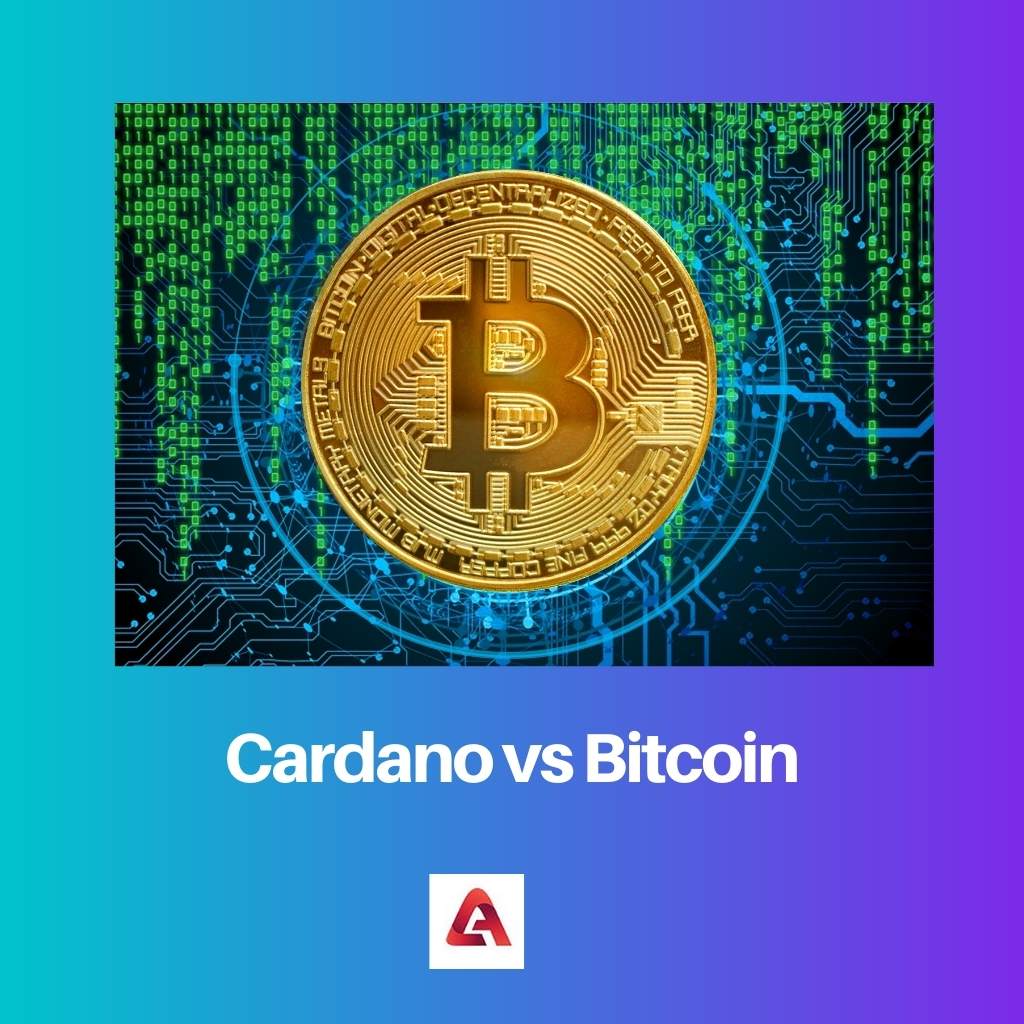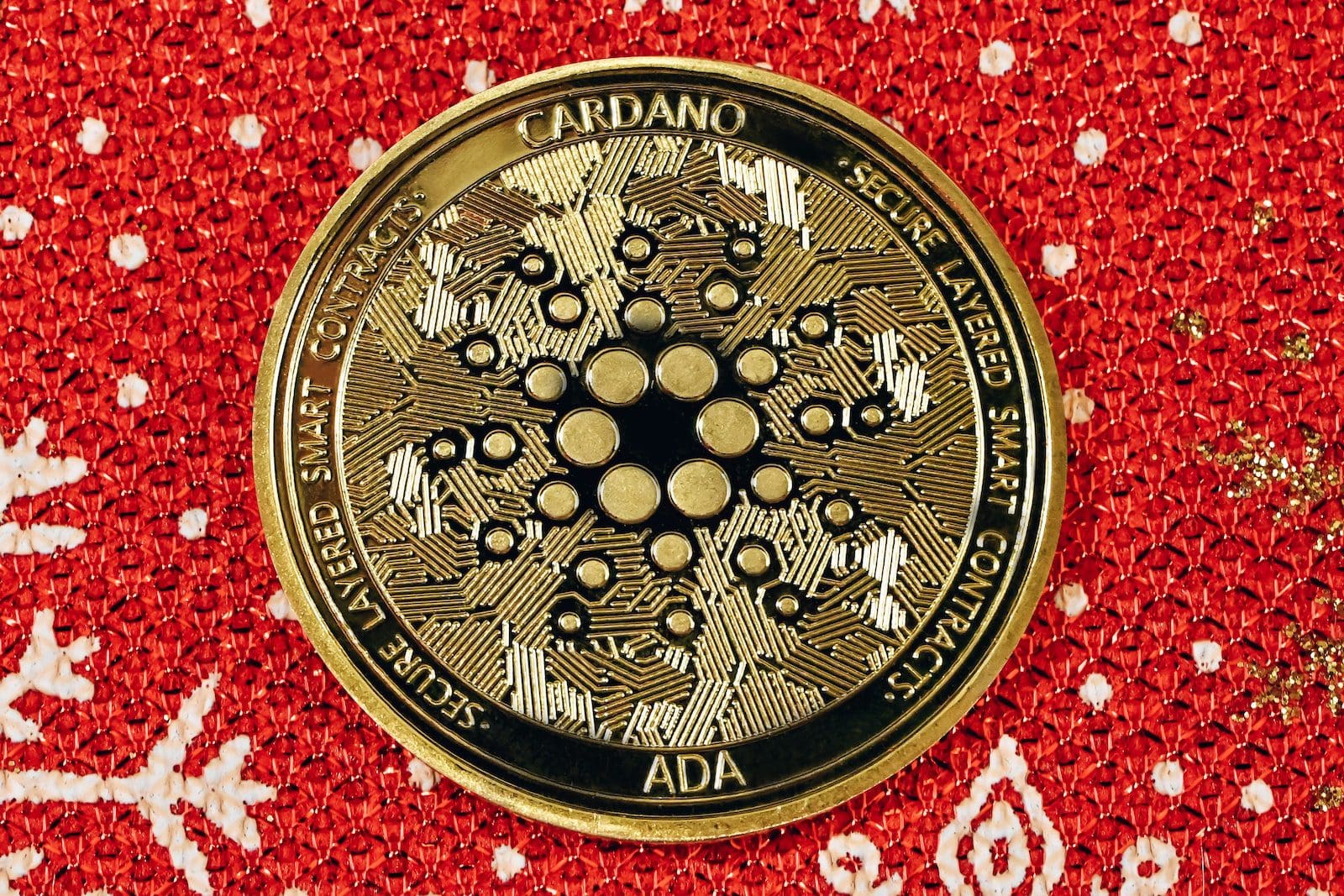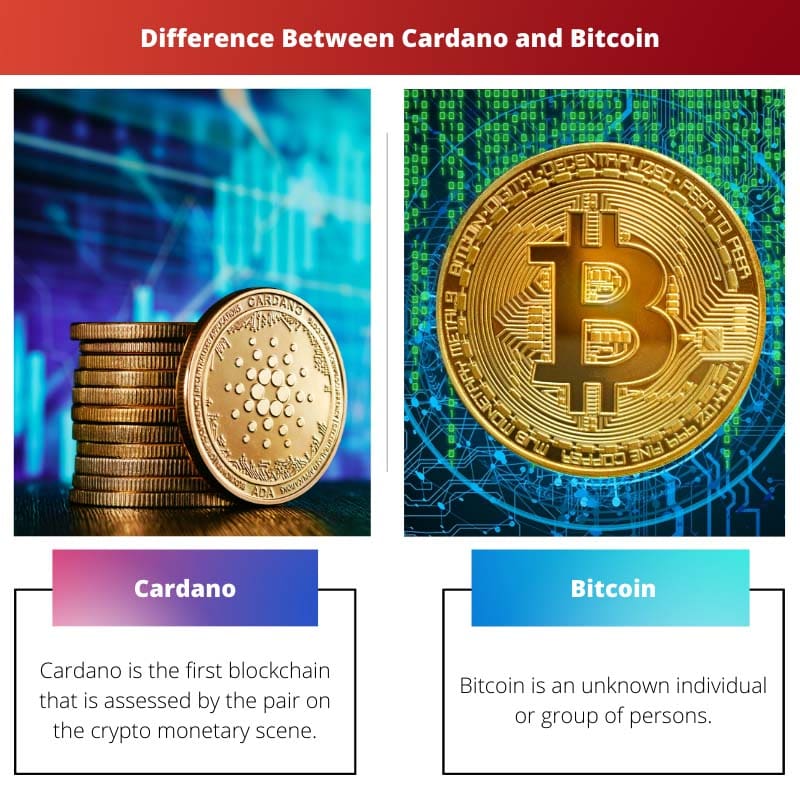Cardano (ADA) and Bitcoin (BTC) differ fundamentally in their approach to blockchain technology. While Bitcoin focuses on being a decentralized digital currency with a limited scripting language, Cardano aims to provide a more versatile and scalable blockchain platform through its layered architecture, incorporating separate settlement and computation layers.
Key Takeaways
- Cardano and Bitcoin are cryptocurrencies, but Cardano aims to improve on Bitcoin’s limitations using a proof-of-stake consensus algorithm.
- Cardano uses a multi-layered architecture that separates its accounting and computation layers, while Bitcoin’s architecture is a single-layered network.
- While Bitcoin’s transaction speed is limited, Cardano claims to have a higher speed and can process up to 257 transactions per second.
Cardano vs Bitcoin
Cardano is a newer blockchain platform that was launched in 2017 by IOHK, a research and development company, using a proof-of-stake consensus algorithm. Bitcoin is the first and most well-known cryptocurrency, created in 2009 by an anonymous person or group using the pseudonym Satoshi Nakamoto.

The Ethereum notion is meant to evolve next-gen—a blockchain that’s a flexible, durable, and scalable platform for smart contracts that will allow for the creation of a wide variety of decentralized financial applications, new crypt tokens, games, and more.
The thoughts of the enigmatic and pseudonym Satoshi Nakamoto are presented in a white paper. The name of the individual who devised the technique remains a mystery.
Comparison Table
| Feature | Cardano (ADA) | Bitcoin (BTC) |
|---|---|---|
| Purpose | Decentralized digital currency and platform for smart contracts and dApps | Decentralized digital currency for peer-to-peer payments |
| Consensus Mechanism | Proof-of-Stake (PoS) | Proof-of-Work (PoW) |
| Transaction Speed | Faster (257 TPS and aiming for higher) | Slower (around 5 TPS) |
| Energy Consumption | Significantly lower | High energy consumption |
| Supply | Fixed supply of 45 billion ADA | Fixed supply of 21 million BTC |
| Current Price (as of Mar 8, 2025) | Significantly lower than Bitcoin | Significantly higher than Cardano |
| Market Volatility | Generally higher volatility | Generally lower volatility |
| Smart Contracts | Yes | No (limited functionality) |
What is Cardano?
Cardano is a decentralized blockchain platform that aims to provide a secure and scalable infrastructure for the development of smart contracts and decentralized applications (DApps). Launched in 2017 by Input Output Hong Kong (IOHK), Cardano distinguishes itself through a scientific and research-driven approach, focusing on sustainability, scalability, and interoperability.
Architecture and Consensus Mechanism
Layers of Cardano
Cardano’s architecture comprises two main layers: the Cardano Settlement Layer (CSL) and the Cardano Computation Layer (CCL). The CSL handles transactions and ADA (Cardano’s native cryptocurrency), while the CCL focuses on smart contracts and DApp execution.
Ouroboros Consensus Algorithm
Cardano utilizes the Ouroboros Proof-of-Stake (PoS) consensus algorithm, a fundamental part of its security and scalability. Ouroboros ensures network participants, called stakeholders, play a crucial role in block creation and validation, minimizing the environmental impact compared to traditional Proof-of-Work (PoW) systems.
Native Cryptocurrency: ADA
ADA Token
ADA is the native cryptocurrency of the Cardano platform, facilitating transactions, staking, and governance. It operates on the CSL and can be staked to participate in the consensus algorithm, enabling ADA holders to earn rewards.
Staking Mechanism
Cardano introduces a unique staking mechanism allowing ADA holders to delegate their coins to a stake pool, contributing to the security and decentralization of the network. Stakers receive rewards based on their participation and the overall health of the network.
Smart Contracts and Decentralized Applications (DApps)
Plutus Smart Contract Platform
Cardano’s smart contract functionality is powered by Plutus, a platform that utilizes the functional programming language Haskell. Plutus enables developers to create secure and robust smart contracts with formal verification capabilities, enhancing reliability.
Marlowe for Financial Contracts
Marlowe, a domain-specific language on Cardano, focuses on financial contracts. It simplifies the creation of blockchain-based financial instruments and is targeted at non-programmers, allowing a broader audience to engage with decentralized finance (DeFi) applications.
Governance and Sustainability
Voltaire: Cardano’s Governance Model
Cardano’s governance model, named Voltaire, introduces a decentralized decision-making process. ADA holders can participate in proposing and voting on protocol upgrades and improvement proposals, ensuring a more inclusive and democratic governance structure.
Treasury System
To support the platform’s ongoing development, Cardano employs a treasury system. A portion of transaction fees and staking rewards is allocated to the treasury, providing funding for projects that enhance and expand the Cardano ecosystem.
Interoperability and Future Developments
Interoperability with Other Blockchains
Cardano aims to achieve interoperability by facilitating communication between different blockchains. This feature is crucial for the broader adoption of blockchain technology and the development of a decentralized global financial ecosystem.
Future Roadmap
Cardano has an ambitious roadmap that includes the implementation of additional features such as sidechains, metadata transactions, and further optimizations. The project continues to evolve, driven by a commitment to research, innovation, and community involvement.

What is Bitcoin?
Bitcoin, introduced in 2009 by an unknown person or group using the pseudonym Satoshi Nakamoto, is a decentralized digital currency. It operates on a peer-to-peer network, allowing users to transact directly without the need for intermediaries like banks.
How Bitcoin Works
1. Blockchain Technology
Bitcoin transactions are recorded on a public ledger known as the blockchain. The blockchain is a decentralized and immutable database that ensures transparency and security. It consists of blocks linked together in a chronological chain, with each block containing a list of transactions.
2. Mining
Bitcoin transactions are validated and added to the blockchain through a process called mining. Miners use powerful computers to solve complex mathematical puzzles, and the first miner to solve the puzzle gets to add a new block to the blockchain. This process also introduces new bitcoins into circulation as a reward for the miner’s efforts.
Key Characteristics
1. Decentralization
Bitcoin operates on a decentralized network of nodes, eliminating the need for a central authority. This decentralized nature makes it resistant to censorship and interference from governments or financial institutions.
2. Limited Supply
Bitcoin has a capped supply of 21 million coins, making it a deflationary asset. This scarcity is designed to mimic the scarcity of precious metals like gold and aims to prevent inflation over time.
3. Anonymity
While Bitcoin transactions are recorded on the blockchain, the identities of the parties involved are pseudonymous. Users are identified by alphanumeric addresses rather than personal information.
Investing and Trading
1. Volatility
Bitcoin’s price is known for its high volatility, with significant price fluctuations occurring within short periods. This volatility can present both opportunities and risks for investors and traders.
2. Exchanges
To buy, sell, or trade Bitcoin, individuals typically use cryptocurrency exchanges. These platforms facilitate the exchange of Bitcoin for fiat currency or other cryptocurrencies.
Challenges and Concerns
1. Regulatory Uncertainty
Governments around the world are still developing regulatory frameworks for cryptocurrencies. The evolving regulatory landscape poses challenges and uncertainties for Bitcoin users and businesses.
2. Security Risks
While the blockchain itself is secure, individual users may face risks such as hacking, fraud, and the loss of private keys. Proper security measures, such as using hardware wallets, are crucial for protecting Bitcoin holdings.
Future Outlook
1. Mainstream Adoption
Bitcoin’s adoption continues to grow, with increasing acceptance by businesses and financial institutions. Some see it as a potential store of value or a hedge against inflation.
2. Technological Developments
Ongoing developments, such as the implementation of the Lightning Network to improve scalability and reduce transaction fees, contribute to the evolving landscape of Bitcoin and its usability.

Main Differences Between Cardona and Bitcoin
- Consensus Mechanism:
- Bitcoin: Uses Proof of Work (PoW) consensus mechanism, where miners compete to solve complex mathematical puzzles to add new blocks to the blockchain.
- Cardano: Utilizes a Proof of Stake (PoS) consensus mechanism, which relies on participants (stakeholders) holding and “staking” their cryptocurrency to validate transactions and create new blocks.
- Smart Contracts:
- Bitcoin: Primarily designed for peer-to-peer transactions and store of value, lacks native support for complex smart contracts.
- Cardano: Developed with a focus on smart contracts, enabling the creation of decentralized applications (DApps) with more advanced functionalities.
- Programming Language:
- Bitcoin: Employs a custom scripting language for its transactions.
- Cardano: Utilizes Haskell-inspired scripting language called Plutus for creating smart contracts.
- Governance and Upgrades:
- Bitcoin: Governed by a decentralized network of miners, and upgrades require broad consensus among the community.
- Cardano: Introduces a formal governance structure through its treasury system and voting mechanism, allowing the community to participate in decision-making.
- Development Approach:
- Bitcoin: Originated as an open-source project led by an anonymous entity (or group) known as Satoshi Nakamoto.
- Cardano: Developed by a team of engineers and academics, led by IOHK (Input Output Hong Kong) and co-founded by Charles Hoskinson.
- Scalability Solutions:
- Bitcoin: Faces challenges with scalability due to the PoW consensus mechanism and block size limitations.
- Cardano: Addresses scalability through its layered architecture, allowing for scalability improvements as the network grows.
- Interoperability:
- Bitcoin: Primarily operates as a standalone blockchain without native support for interoperability with other blockchains.
- Cardano: Aims to facilitate interoperability between different blockchains, fostering a more connected and collaborative ecosystem.
- Philosophy and Research-Driven Approach:
- Bitcoin: Rooted in the principles outlined in the Bitcoin whitepaper, emphasizing decentralization and security.
- Cardano: Embraces a research-driven approach, focusing on academic rigor and formal methods to ensure the security and reliability of the platform.




